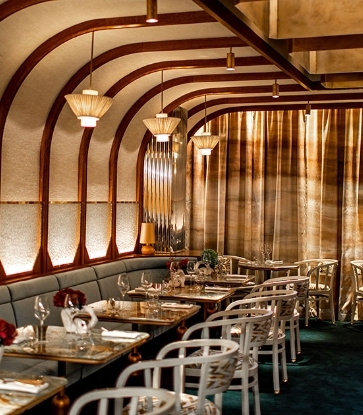It may be a sign of the times.
The turbulent economic landscape has many in Paris saying “stop” to the ever-escalating cost of living. Or is it simply a swing of the culinary pendulum, adjusting after a decade or more turned toward lighter, sauceless dishes, smaller portions, vegetarian specialties, sharing and snacking?
Whatever the reason, the good old-fashioned brasserie, and even more old-fashioned “bouillon,” both proposing simple, nostalgic dishes at affordable prices, have made an astonishing comeback recently.
In the list of French restaurant styles, the traditional brasserie is one of the most convivial, brightly lit and bustling, with clients from all horizons, amidst a ballet of waiters in long black aprons and a menu of traditional dishes. The fare is simple—from œufs mayonnaise, soupe à l’oignon, choucroute garnie and steak frites, to oysters shucked at the raw bars that occupy the corners of their terraces. The beverage of reference is beer, even if good wines are also served. The most legendary Parisian brasseries date back to the beginning of the 20th century, and are often charged with history and beautiful baroque decors.
The brasserie’s less opulent cousin, the bouillon, first appeared around 1860 and was essentially working class, with a simpler cuisine based on—as the name implies—bouillons or broths enriched with bits of meat and vegetables. They evolved from what was believed to be the very first restaurant opened in Paris in 1765 by a soup vendor named Boulanger.

Bouillons had nearly disappeared from the Parisian landscape until very recently and many good old-fashioned brasseries had fallen into a state of lethargy. Their elegant decors, if a little tarnished by time, continued to draw curious tourists, despite the slipping quality of the food. Some of these relics of the past had been nearly totally deserted by the local dining population.
Recently, a crop of restaurants labeled bouillon has resurfaced in Paris, including Bouillon Chartier, Bouillon Julien (formerly just Julien), Le Bar du Bouillon and a new kid on the block, Bouillon Pigalle.
If you pass by the newly hip Bouillon Pigalle in Paris’s 18th arrondissement from around 7:00 p.m. on any given evening, you’ll see a long line snaking up the street in front of a black and glass corner facade with a red neon sign with its name. Opened a little over a year ago, this contemporary reinvention of the classic bouillon is one of the trendiest addresses in the French capital. A vast 300-seat duplex decorated with white subway tiles, red banquets and turned wood chairs, it serves French-style comfort food at remarkably low prices. Poireau vinaigrette (€3.40), foie gras with onion jam (€8.80), agneau cooked for seven hours with haricots blanc (€11.50) or saumon a l’oseille (€13.50) are on the menu. Quantity, turnover (over 1,000 meals are served on the busiest days), closely packed tables and a no-reservation policy (thus the lines), explain the kitchen’s ability to offer quality fare at prices that haven’t been seen in the French capital for a very long time. The success is such that the restaurant has recently published a book of its recipes.
Proposing simple and generous food at a petit price was the aim of two historic Parisian establishments, the Bouillon Chartier (1903) and Bouillon Julien (1906) when they were opened by competing restaurateurs. Both have recently been taken over by different groups riding on the bouillon wave. Their art nouveau decors have been polished up and their costs readjusted.
At the Bouillon Julien, the founder's promise of "beau, bon et pas cher" ("beautiful, delicious and affordable") has been reinstated by new owner Jean-Noël Dron. After a delicate renovation of its fabulous floral and sculpted wood decor by Majorelle and other art nouveau artisans, it reopened in the fall of 2018. The new menu, crafted by a head chef lured away from a starred hotel restaurant, includes a terrine de volaille et legumes (€5.20), a foie gras de canard (€9.20) and the Bouillon Julien (beef bouillon with tender morsels of beef, ginger and citronella, for €9.90)—a perfect example of the original vocation of these restaurants.

A similar renaissance has marked some of Paris’s most legendary brasseries. Le Train Bleu, set theatrically above the main hall of the busy Gare de Lyon train station, boasts a fabulous gilt-trimmed interior, with giant picturesque canvases painted by famous artists flanking the high baroque ceiling. It recently brought in a new chef, the two-Michelin-star Michel Rostang, to boost the quality of the cuisine. That could explain why prices here are far from those of the new bouillons—the tab can easily go to €90 for three courses.
La Coupole, another Parisian institution in the artsy Montparnasse area, has also experienced a recent resurrection. Opened in 1927, it has a long and colorful history full of artists and writers, including Man Ray and Ernest Hemingway, and more recently tycoons and top models, until its appeal and quality faded after being bought by a restaurant chain in the 1980s. New owners and a dynamic new director have brought this grande dame back to her former sparkling status. Here one can start with the ever popular escargots de Bourgogne (€10 for 6) or a pâté en croûte au foie gras et pistaches (€10.50) and continue with a suprême de volaille jaune de Vendée, crème de morilles (€19.50).
The trend doesn’t seem to waning: The Grand Café Capucines on a boulevard leading to the Garnier Opera has just announced a major lifting, a return to the source, the golden age of the brasserie, reinterpreted by a famous design team, plus a new menu based on seasonal products of quality. “We realized that Parisians had abandoned the café,” says a spokesperson. “One of our goals is to bring them back.”
Hero image coutesy of Benoit Linero.














